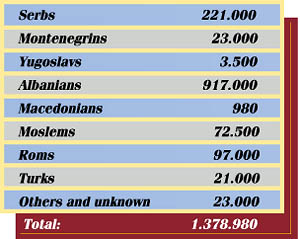
The last census, implemented under the supervision of Federal and Republican organs, which
may be considered objective, is the one of 1961. This census registered 646.605 Albanians.
The censa of 1971 and 1981 were implemented under the supervision of the Kosmet organs. In
the 1981 census, the cooperation of the Republican organs was explicitly rejected, with
the excuse that the statistical organs of the Republic are not competent for the
implementation of the census in Kosovo and Metohija; separatists demonstrations took place
during the census.
Since the 1981 census, there are no exact data about the national
structure of the population of Kosovo and Metohija.
When interpreting the reproduction of the Albanian population, some
comparisons impose themselves. First of all, one should compare the pace of renewal of the
population in the Entire area populated by Albanians, i. e. see whether there exist some
differences, and what are the differences in the reproductive behavior of the Kosmet
Albanians, in comparison with their compatriots in Macedonia and Albania.
If we take as parameter the population in Albania, then, according to
that base, which increased, according to the Albanian official data 2.9 times since 1945,
we must conclude that the Albanian population in Kosovo and Metohija increased 2.5 times
at most, during that same period. This is due to the fact that the living standard in
Kosovo and Metohija is much higher and that women are far more emancipated. If we decrease
that number for the rather great number of members of the Albanian national minority who
left, during a long time period, Kosovo and Metohija because of economic reasons, we get
an estimate of 917.000 members of the Albanian national minority in Kosovo and Metohija
today.\
The confirmation of this statement, namely that there are no more than
900.000 Albanians in Kosovo and Metohija is obtained in the recent census in Macedonia
(1994). According to the jointly implemented census in 1991 in 1991, there were 427.313
Albanians in Macedonia. The Albanian sources offered several times assessments saying that
there are some 600.000, maybe even 800.000 Albanians in Macedonia; that there are 200.000
Albanians in Skoplje only, etc. However, the newest census, in 1994, showed that the
optimum number would be somewhere around 484.000. Namely, in order to make it comparable
to the previous censa, all persons residing abroad were included in this number, although
they should have been excluded, according to the international criteria.
The effect of the rigorous procedures of control under the supervision
of the international community, and of the strict respect of the rules of census
(according to which two census takers visited all households, one Albanian, and one
non-Albanian), was such that the number of registered Albanians was far below the
announced by the Albanians before the census. The application of the same principles in
Kosovo and Metohija will confirm the assessment presented here.
The Albanian population in Macedonia increased from 197.389 in 1948, to
377.208 in 1981, which means 1.9 times. According to the data supplied by the organs of
the Province, during that same period the number of Albanians in Kosovo and Metohija
increased from 498.242 in 1948, to 1.596.072 (1981), which would mean a 3.2 times
increase. Such a difference can not be explained by any rational arguments, for it would
mean that the Kosmet Albanians reproduced themselves 1.7 times more rapidly than those in
Macedonia.
Since this is the same geoethnic area, since the conditions of life are
similar, the rates of growth of Albanians, Roms and Turks must be similar.
However, if we compare the rates of natural growth of Albanians, Roms
and Turks in the period 1981-1990 in Macedonia and in Kosovo and Metohija, we will see
that the results look like comparisons between different peoples in different countries.
In Macedonia, the number of newly arrived Albanians decreased from 22.2
to 1.000 Albanians to 19.7 in 1981. However, the natural rate of growth of Albanians in
Kosovo and Metohija was shown by the figures obtained in the controversial census, as 27.6
in 1981, which means that the Albanian population to 1.000 grew by 4.5 persons more in
Kosovo and Metohija in comparison with Macedonia, which is highly improbable. This
difference was then even increased in individual years, so that in 1984 there were even
9.3 persons more per 1.000, 8.;3 persons in 1987, etc.
It is a well known fact that the Roms have the highest birth rate and
the highest rate of natural renewal. The comparison between Macedonia and Kosovo and
Metohija "denies" such a statement. The natural rate of growth of the Roms in
Kosovo and Metohija was almost twice smaller (17.4), than that in Macedonia (30.7). The
situation with the Turks is similar. The number of Turks in Kosovo and Metohija decreased
from 34.500 in 1953 or 25.700 in 1961 to only 10.500 in 1991.
At the basis of the above mentioned data, we can conclude that almost
the entire population growth of Roms and Turks in the Province was ascribed to Albanians.
Therefore, we could assume that there are twice as many Roms and Turks than it is shown by
the figures about their number and natural rate of growth; the Albanian population must be
decreased for that number.